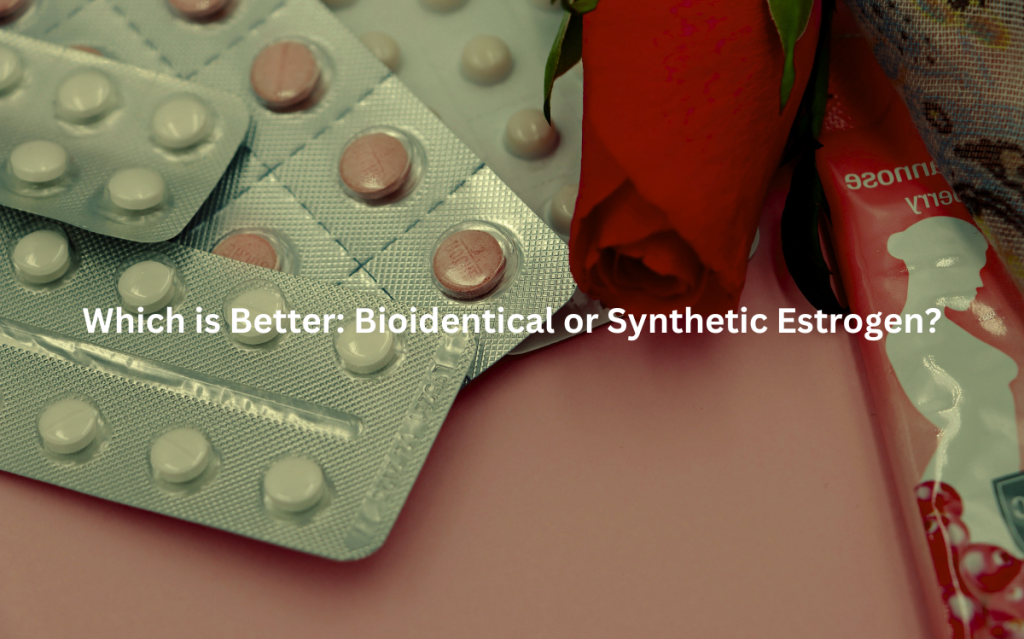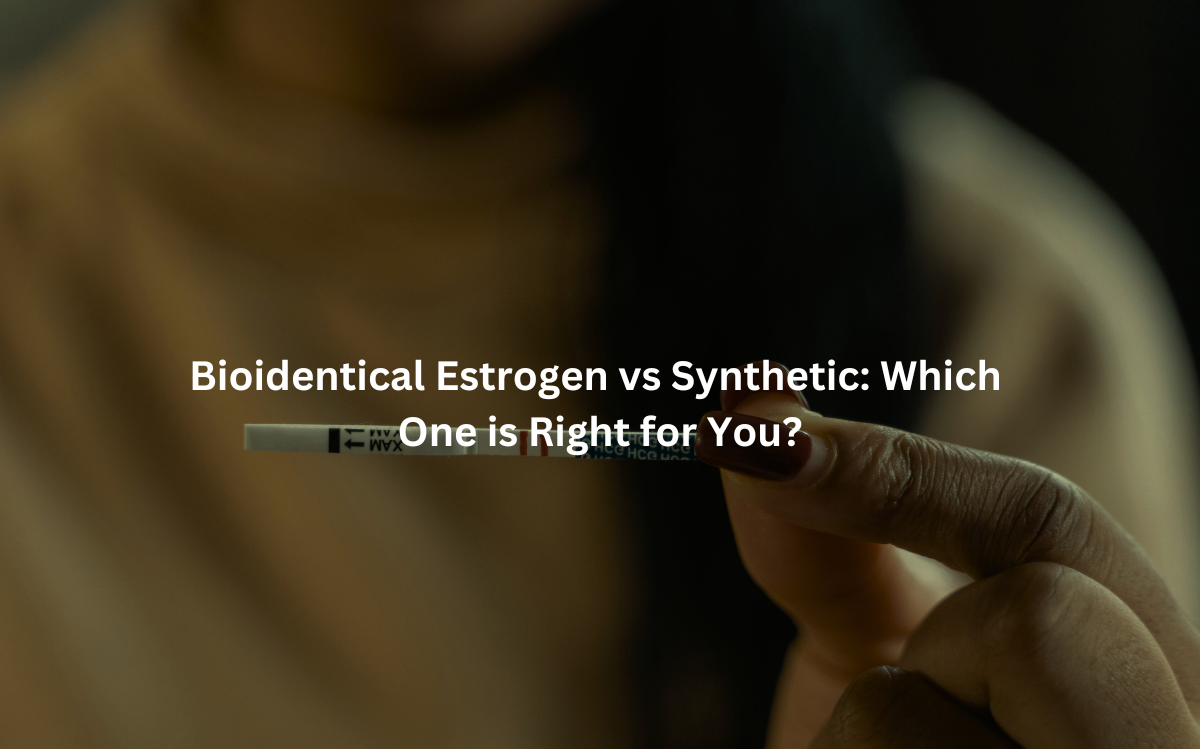Understand the key differences between bioidentical and synthetic estrogen to make the best choice for menopause relief.
When it comes to managing menopause symptoms, choosing the right estrogen therapy is crucial. Bioidentical estrogen and synthetic estrogen are two popular options, each offering unique benefits and risks. (1)
But which one should you choose? In this article, we’ll break down the key differences between bioidentical and synthetic estrogen, helping you make an informed decision for your health and comfort.
Key Takeaway
- Bioidentical estrogen is molecularly identical to the body’s natural estrogen, providing a more familiar hormonal balance.
- Synthetic estrogen, while effective, may have higher risks due to its artificial structure.
- Both options offer relief from menopause symptoms but differ in long-term health impacts.
Understanding Estrogen and Its Role in the Body
Estrogen is more than just a hormone responsible for reproductive functions. It plays a key role in maintaining bone density, heart health, and cognitive function.
As women age and approach menopause, estrogen levels drop, leading to common symptoms like hot flashes, night sweats, and mood swings. This is where estrogen replacement therapies come into play, with bioidentical and synthetic options leading the way. While both aim to replace lost estrogen, how they do it and the risks involved differ considerably.
What is Bioidentical Estrogen?
Bioidentical estrogen is chemically identical to the estrogen naturally produced by the body. Derived from plants like soy or yams, it’s processed to mirror the estrogen molecules that exist in the human body. Bioidentical hormones come in various forms, including creams, pills, and patches, and can be prescribed as regulated therapies or compounded by pharmacists to meet individual needs.
The Benefits of Bioidentical Estrogen
Because bioidentical estrogen mimics the body’s natural hormones, proponents argue that it’s more easily absorbed and used by the body. Studies suggest that bioidentical hormones may provide more effective symptom relief for menopause while potentially offering fewer side effects.
For example, women who use bioidentical estrogen often report smoother transitions with less risk of blood clots or heart disease, though risks still exist, particularly with compounded forms.
The Risks of Bioidentical Estrogen
Despite the advantages, bioidentical estrogen is not without its downsides. The biggest concern is the use of compounded bioidentical hormones, which are not Health Canada-approved and come with uncertain safety profiles.
These compounded hormones are often marketed as a “natural” solution, but their quality control is not standardized, leading to potential risks such as improper dosages and contaminants. Regulated bioidentical estrogens, however, are considered safe when prescribed by a physician.
What is Synthetic Estrogen?
Synthetic estrogen, on the other hand, is chemically altered and does not exactly replicate the estrogen produced by the body. The most common synthetic estrogen used in hormone replacement therapy (HRT) is ethinylestradiol, often combined with progestin in hormone pills.
Synthetic estrogen has been used for decades, with an established safety profile for many women, though it does come with more noted risks compared to bioidentical alternatives. (2)
The Benefits of Synthetic Estrogen
Synthetic estrogen is known for its consistency in dosage and availability. It’s widely studied and approved by Health Canada, which means it’s generally considered safe when used appropriately.
It effectively manages symptoms like hot flashes and vaginal dryness, which can drastically improve a woman’s quality of life during menopause. Additionally, synthetic estrogen is more affordable and accessible, especially when it’s covered by insurance.
The Risks of Synthetic Estrogen
Despite its widespread use, synthetic estrogen has been linked to increased risks for certain health issues, particularly when used for extended periods. One of the main concerns is an increased risk of blood clots, stroke, and breast cancer, particularly with long-term use.
The combination of estrogen and progestin has been shown to slightly increase the risk of breast cancer, although this risk is not universal and depends on other factors such as age, weight, and medical history.
Which is Better: Bioidentical or Synthetic Estrogen?

When comparing bioidentical and synthetic estrogen, the right choice largely depends on individual health needs, risk factors, and treatment goals. Both options provide significant relief from menopause symptoms, but they come with different safety profiles.
Personal Health Considerations
For women with a family history of breast cancer or cardiovascular disease, synthetic estrogen may not be the best choice due to the associated risks.
On the other hand, women who are looking for a more “natural” approach may lean towards bioidentical estrogen, especially if they want something that mimics the body’s natural hormone. However, it’s important to note that not all compounded bioidentical estrogen is equally safe, and its use should be discussed with a healthcare provider.
Symptom Relief and Effectiveness
Both types of estrogen are effective in relieving menopause symptoms like hot flashes and vaginal dryness. Bioidentical estrogen may provide a more personalized approach, especially when it’s compounded to meet a woman’s exact hormonal needs.
Synthetic estrogen, while effective, may be less flexible in terms of dosage adjustments. Women looking for a standard, reliable treatment might prefer synthetic estrogen.
Risks and Long-Term Considerations
Long-term health risks differ between the two forms of estrogen. For example, bioidentical estrogen, especially when used in regulated forms, might present fewer risks for heart disease and clotting. However, the safety of compounded bioidentical hormones remains uncertain.
Synthetic estrogen, while offering predictable results, carries a slightly higher risk of certain cancers and cardiovascular events, especially in women over the age of 60 or those with certain medical conditions.
Making an Informed Decision
Ultimately, the decision between bioidentical and synthetic estrogen should be based on a thorough understanding of one’s health, risks, and treatment goals.
Consulting a doctor is key, as they can provide tailored advice based on individual needs. Women should weigh the benefits of symptom relief against the potential risks, considering their medical history, lifestyle, and personal preferences.
Managing Menopause Symptoms Without Hormone Therapy
For women who are hesitant to use hormone therapy, several non-hormonal treatments can help alleviate menopause symptoms. Lifestyle changes such as regular exercise, stress management, and dietary adjustments can reduce hot flashes and improve overall well-being.
Non-hormonal medications like SSRIs and SNRIs can also help manage mood swings, though they might not be as effective as estrogen-based treatments.
Non-Hormonal Alternatives for Symptom Relief
For women with contraindications to HRT, non-hormonal options such as herbal remedies (black cohosh, soy isoflavones) or acupuncture might provide some relief.
Though the evidence for these treatments is mixed, they remain popular among women looking for natural symptom management.
Conclusion: Tailoring Your Approach to Menopause
Menopause is a significant life transition, and finding the right treatment requires careful consideration of both options—bioidentical and synthetic estrogen. Both have their benefits and risks, but the right choice will depend on your health goals, medical history, and personal preferences.
Regular consultations with a healthcare provider are essential to ensure the safest and most effective approach to managing menopause symptoms. After all, the goal is to feel like yourself again—comfortable, healthy, and in control.
If you’re ready to take the next step, book your consultation with Modern Menopause today and start feeling like yourself again. Book now.
FAQ
What are the key differences between bioidentical estrogen and synthetic hormones for menopause management?
Bioidentical estrogen is chemically identical to the hormones produced by the human body, while synthetic hormones are altered forms that may not match natural hormone levels.
Both types of hormones are used in hormone therapies to manage menopausal symptoms, but the safety and effectiveness of bioidentical estrogen can vary depending on treatment options, especially if compounded by pharmacies. It’s important to consult healthcare providers to make informed decisions based on the risks and benefits of each approach.
How do synthetic hormones compare to bioidentical estrogen in terms of long-term health effects?
Synthetic hormones and bioidentical estrogen can both be effective in treating menopausal symptoms, but their long-term effects can differ. Bioidentical estrogen is often preferred for its closer similarity to hormones produced by the human body, but the safety and effectiveness can vary depending on the form and source.
Synthetic hormones, while Health Canada approved and widely used, may carry different risks and benefits for long-term health, such as heart disease or osteoporosis. Women should discuss hormone treatments with their healthcare provider to weigh the risks and benefits.
Are bioidentical hormones safer than synthetic hormones for treating menopausal symptoms?
While some believe bioidentical hormones are safer due to their similarity to natural hormones, the safety and effectiveness can depend on individual health conditions and treatment options.
Both bioidentical and synthetic hormones can carry risks such as blood clots, cardiovascular issues, and cancer with long-term use. Bioidentical hormones, particularly those produced by compounding pharmacies, may not always be regulated, which can affect their safety. It’s crucial to explore hormone therapies with a healthcare professional to ensure the best choice for symptom management.
What are the main risks and benefits of using bioidentical estrogen compared to synthetic estrogen?
The benefits of bioidentical estrogen include its similarity to the hormones produced by the human body, which may reduce certain risks like breast cancer or blood clots, especially in younger women. Synthetic estrogen, while effective, carries known risks such as cardiovascular issues and increased breast cancer risk with long-term use.
Both hormone treatments help manage menopausal symptoms and protect against osteoporosis, but informed decisions should be made with healthcare professionals to assess the specific risks and benefits for each woman.
Can compounded bioidentical hormones be used safely, and how do they compare with synthetic hormone products?
Compounded bioidentical hormones, made by specialized pharmacies, are not Health Canada-approved and may vary in strength and formulation.
While they are designed to closely match the hormones produced by the human body, their safety and effectiveness can be unpredictable, especially when compared to Health Canada-approved synthetic hormones. It’s important to carefully evaluate treatment options and consult healthcare providers about the potential risks and benefits of compounded bioidentical hormones before use.
How do bioidentical estrogen and synthetic hormones affect hormone levels during menopause?
Both bioidentical estrogen and synthetic hormones aim to restore estrogen levels that decline during menopause. Bioidentical estrogen mimics the hormones naturally produced by the body, while synthetic estrogen may be a different chemical structure.
Both types of hormones can help manage symptoms like hot flashes, night sweats, and mood swings by stabilizing hormone levels. However, the way they interact with the body can differ, so healthcare professionals should tailor hormone therapies to individual needs, considering hormone levels and health history.
What are the best treatment options for managing menopausal symptoms with hormone therapies?
Hormone therapies, including both bioidentical estrogen and synthetic hormones, are effective for managing symptoms like hot flashes, mood swings, and sleep disturbances.
The treatment options depend on individual health profiles, with bioidentical estrogen being a popular choice for some women due to its natural composition.
Synthetic hormones, often Health Canada approved, are another reliable option, especially for women needing more regulated doses. It’s essential to discuss with a healthcare provider to determine the best approach based on symptoms and long-term health considerations.
How do hormone treatments affect menopausal symptoms and overall health?
Hormone treatments, whether bioidentical or synthetic, help alleviate common menopausal symptoms such as hot flashes, night sweats, and mood swings by restoring hormone levels.
In addition to symptom relief, hormone therapies protect against long-term health risks like osteoporosis and heart disease, which are linked to declining estrogen levels.
While bioidentical hormones are favored by some for their similarity to natural hormones, synthetic hormone treatments are widely used and Health Canada approved for long-term health management. Both require ongoing monitoring to ensure safety and effectiveness.
References
- https://pubmed.ncbi.nlm.nih.gov/19179815/
- https://pmc.ncbi.nlm.nih.gov/articles/PMC3635108/

Leave a Reply